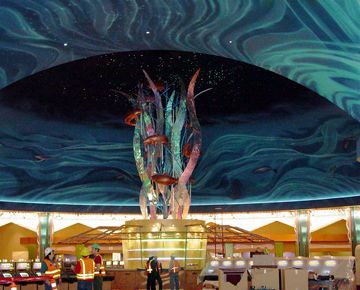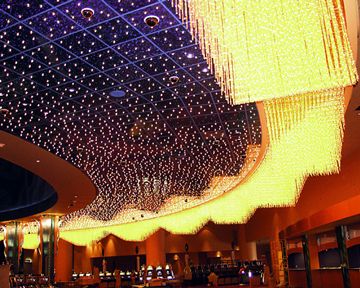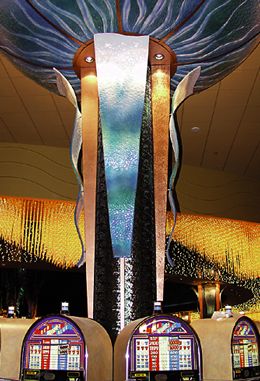
Published May 2003
For
gamers or diners, new casino
has a WOW! impact everywhere you look
By
John Wolcott
SCBJ Editor
WOW!
That’s what Chief Operations Officer Chuck James wants to hear when people walk into the new $72 million Tulalip Casino. When it opens at 8 p.m. June 5, he and hundreds of others who have worked for two years to create that WOW! will be watching and listening.
 |
| Photo courtesy
of Tulalip Tribes In late April, workers were finishing work on the focal point of the new Tulalip Casino, the giant 100-foot-high dome where 10-foot-long copper salmon swim through a seaweed sculpture into a night sky lighted by fiber-optic stars arranged to mimic the natural Pacific Northwest constellations. |
They don’t really expect people will disappoint them.
Since construction began in April 2001, James has been telling people about the new casino, four times the size of the one the Tulalip Tribes opened in 1992 across the street from the Best Western Tulalip Inn, and telling them about all of its WOW! features.
Soon they’ll get to see them.
Even the mammoth size of the lighted parking lot for more than 5,000 vehicles around the casino has its own “wow” factor, along with the realistic rock outcropping with its alpine trees that the Tulalips created as a focal point for entering and exiting the casino’s main entryway.
The realistic 40-foot-high rock “island” provides the nucleus for a roundabout circle loop that controls traffic without installing unsightly traffic lights.
As traffic moves toward the casino, there are more sights to see, from the Orca whale — “black fish” the Tulalips call them — in the first pond to the 20-foot-tall Indian spear-fisherman poised above large replicas of swimming salmon in the second pond.
There are more gardens, ponds and fountains to see before reaching the entrance to the casino, an entrance framed by cascading waterfalls on the walls of the casino.
The Tulalips have planned carefully to create a Pacific Northwest setting in the midst of Quil Ceda Village’s expanses of concrete and asphalt beside a major freeway.
Once inside the casino, visitors enter a colorful world of fantasy, food and games designed to satisfy their cravings for entertainment, relaxing, socializing and, of course, winning money.
As guests become immersed in the vast array of 2,000 illuminated video “slot” machines, gaming tables for roulette and blackjack, a variety of restaurants from buffets to fine dining and the dazzling lighting displays, guests will easily sense the Tulalips’ traditional love of the natural world, feelings expressed in the decor of the entire casino.
Just inside the entrance doors is a 32-foot-high ceiling cove with a hand-painted mural that depicts the upstream journey of salmon, the prized fish treasured by Northwest Indians who have traditionally made their living from the sea.
Following the salmon’s journey leads visitors to the center of the casino, where above a 60-foot-diameter circular bar rises a sculpture of a seaweed forest, home to several 6-to-8-foot-long copper salmon swimming upward into the blackness of the 100-foot-high domed ceiling.
The night sky of the dome provides the setting for thousands of fiber- optic “stars” that form an exact replica of the natural Northwest sky outside, complete with the Big Dipper and the North Star.
 |
| Snohomish County
Business Journal/JOHN WOLCOTT Tens of thousands of light-cicles form a curtain of light near the center of the Tulalip Casino, part of the wide array of lighting effects featured in the facility. |
Around the bottom of the dome is a wide border of glittering aqua-blue star lights and a sparkling band of thin tubular light-cicles — thousands of them — that reflect off the copper canopy of the circular bar. The lower part of the dome ceiling has custom-created copper-gold paneling, embossed with rippling waves to extend the water theme into new areas.
Outside of the dome area, flanking the north and south entrances to the casino, the ceiling’s colors range from darker shades of blue in the north to lighter shades in the south.
To add dimension to the ceiling, there are 70 large custom-crafted art pods hanging throughout the casino, representing canoes, waves, leaves, shells, wind, branches and smoke, part of the “natural elements” theme seen throughout.
From the middle of the casino, rows of video “slots” stretch in every direction, with aisle-ways marked by numerous light columns rising from the floor. Covered with iridescent dichroic aqua-blue fish scales, the artfully designed curved columns are topped with 12-foot-diameter resin bowls that are colored and lighted in different hues.
|
Tulalip
Tribes Herman A.
Williams Jr., Tribal Chairman Quil Ceda Village Council Stanley G.
Jones Sr., Herman A.
Williams Jr., John R. McCoy,
Primary Tulalip Casino Contractors Architect:
Interior
design: Electrical
contractor: Air-conditioning
and heating systems: Civil engineering:
Landscape architect: KLLA Design/build
contractor for entry features: General contractor: Mortenson-Gobin |
“The Tulalip Casino needed to be a combination of Northwest Native American culture with a touch of Las Vegas, but primarily it’s Northwest Indian, reflected in the main theme of the decor, the natural elements of earth, wind, fire and water,” said Shirley LaFollette of Seattle, the president and owner of Interior Design International Inc.
It was her experience in designing themes for hospitality facilities, blended with the vision of the Tulalip Tribes, that created the decor for the Tulalip Casino.
Some Native American casinos present the feeling of a cultural museum, she said, but “this one takes their culture and puts it into a very modern setting. Everywhere you look there are tree branches, fish shapes, waterfalls and painted skies with stylized eagles in the ceiling.”
But the design was also aimed at making people feel comfortable and relaxed in the casino environment.
“The idea is to help people forget the outside world, to come in and have fun. It’s a fantasy world and you need to design a casino setting to accomplish that,” she said. “The artwork is very Northwest, very Native American, but there is also the lighting and glitter of a casino.”
Around the perimeter of the gaming area are some 50 gaming tables, including a poker room with 10 tables, and a 50-seat Keno area, plus the “high roller” room with its Blackjack and baccarat games, VIP lounge, television, private area for cell phone calls, and a manager on duty at all times for the guests’ needs.
The casino’s 227,000 square feet of space is most noticeable in the gaming floor and the restaurants, but the building also houses a kitchen and bakery, the employees’ exercise and lunch rooms, administrative offices and five mezzanine areas for such things as the computers and electronic controls for the casino’s video slots and the casino’s widespread but unobtrusive security system.
Next to gaming, eating is one of the favorite pastimes at casinos, and the Tulalips have prepared four different types of restaurants and menus for that kind of entertainment.
- Canoes is a cabaret with seating for 300 and room for up to 450 during special events. A carvery is attached to Canoes.
- Eagles is a buffet-style restaurant seating up to 300 people. Its ceiling is decorated with a hand-painted sky filled with large iridescent eagles soaring among the clouds.
- Cedars is a 24-hour café designed in earth tones, featuring a rock wall made of quartzite. A water fountain decorates the entry to the restaurant.
- At Tulalip Bay, “fire” is the theme of the decor, which includes a fired blown-glass chandelier created by Tacoma’s internationally known artist, Dale Chihuly. The fine-dining restaurant seats adjoins a wine room separated from the restaurant by a large, hand-carved crystal image of Tulalip Bay.
 |
| Snohomish County
Business Journal/JOHN WOLCOTT Cedars is a cafe, Canoes is a cabaret, Eagles is a buffet restaurant and Tulalip Bay is a fine-dining meal destination, all part of the Tulalip Casino’s varied choices. |
Throughout the casino, one normal element of most casinos is missing — cigarette and cigar smoke, a boon for regular patrons and an invitation to those who have stayed away because of the older casino’s smoky environment.
One of the first fresh-air systems of its kind in North America has been installed at the Tulalip Casino to provide a clean, smokeless setting by bringing air into the casino from the floor and drawing it out at the ceiling, carrying the smoke with it.
Air in the casino will be changed 20 to 30 times each hour, a feature of critical concern for the Tulalips for the health of their customers and employees, said the casino’s Chief Operating Officer, Chuck James.
There are 971 people employed at the casino, James said, but that number will grow to around 1,400. About 80 percent of the managers and 50 percent of the employees will be tribal members, James said.
The total economic impact of the new casino is difficult for people to grasp. But the past performance of the first casino — and the Tulalips’ detailed market studies of the potential for the new casino’s growth — portray a bright picture.
James said an anticipated 9,000 people a day are expected to visit the new casino, on average, and that will mean a significant impact on the entire area’s economy.
Much of the bright economic future the Tulalips see ahead for the north Snohomish County area will be of their own doing. The tribes expect to build a 500-room hotel soon adjacent to the new casino, followed by a second hotel as the demand grows, along with a convention center.
The addition of a large factory-outlet mall at the north end of Quil Ceda Village’s business park will include national brand merchandise.
The Tulalips also are continuing to pursue plans for other attractions, including a regional amusement park that is expected to be on a par with the Six Flags parks in Texas and similar major entertainment destinations elsewhere in the country.
When Quil Ceda Village is fully developed it is anticipated that visitors will number as high as 14 million annually, making Snohomish County one of the Pacific Northwest’s major shopping and entertainment destinations for Canada, the Western United States and beyond.
That’s an impressive goal, one that shows the Tulalips have the courage to place some big bets of their own as they move closer to their goal of economic and social self-sufficiency.
But big goals and big numbers become more real with each new successful venture of the Tulalip Tribes, ventures that have been successful enough to attract the attention of a group of national financial sources led by Bank of America and Wells Fargo Bank.
They’ve been impressed enough to step up to $120 million in loans to accelerate the pace of the Tulalips’ growth scenario.
While past performance is no guarantee of future performance, it still remains one of the most reliable indicators available. So far, the tribes’ past successes have bridged a lot of credibility gaps in the financial world, in government and political arenas and in the public’s collective mind.
Tribal successes have also dramatically changed the course of history for the Tulalips.
Only a couple of decades ago, a majority of the tribal members depended on welfare checks, unemployment was over 60 percent, the Indians’ fishing and logging jobs were declining and no one dared predict a bright economic future for the Tulalip Tribes.
Even 10 years ago, the tribes relied on federal and state grants for 95 percent of their annual budget. But as recently as 2000, tribal businesses — including the casino and bingo hall — provided 75 percent of the tribal budget.
It was just three years ago this spring that the Tulalips announced the first tenants for the Quil Ceda Business Park, before it was incorporated as a municipality, Quil Ceda Village. That summer, construction began on the Wal-Mart store, followed months later by Home Depot.
The next development was the Quil Ceda Neighborhood Shopping Center that now houses more than a dozen businesses and the Greater Marysville Tulalip Chamber of Commerce.
 |
| Snohomish County
Business Journal/ JOHN WOLCOTT Colorful light columns line the aisles of the casino, with many of them surrounded by illuminated video “slot” machines that will soon be seeing a lot of action. |
Two years ago, in April 2001, construction began on the Tulalip Casino, a project rising from the scrub grasses and weeds of reservation flatland adjacent to I-5. Watched by tens of thousands of motorists daily, the project has attracted a lot of attention, as well as anticipation.
Now that the casino is opening, it’s yet another example of what the Tulalips have learned to accomplish in their pursuit of new ventures in search of employment and economic stability for their people.
Today, when people hear that the Tulalips are planning hotels, amusement parks, outlet malls and conference centers, they easily believe those things will be accomplished.
While great plans and great hopes always make great topics for speculation and discussion, the reality is that these are times when predicting anything seems to be more perilous than usual.
Yet the Tulalips seem to continue defying present economic doldrums that have stymied other developers.
Because of their successes the rest of the county’s economy has also benefitted. Now, with the opening of the new Tulalip Casino on June 5, the local Snohomish County economy — as well as the Pacific Northwest economy — is about to reap another boost from the Tulalips’ efforts.
WOW!
Back to the top/Tulalip Casino Main Menu